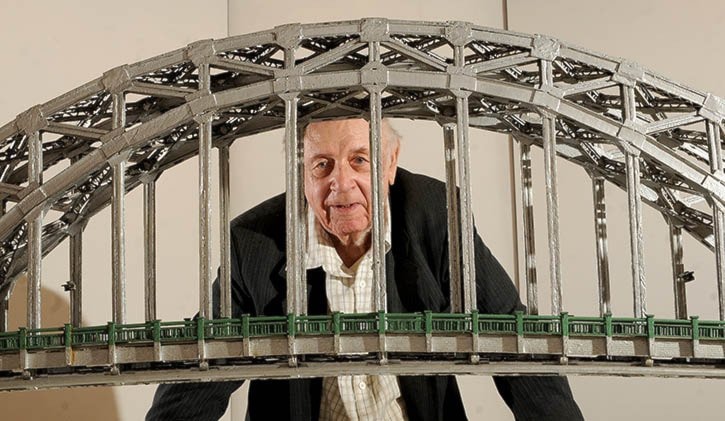There’s not a lot of love for the Pattullo Bridge these days.
But the venerable old crossing over the Fraser River that links New Westminster to Surrey helped put Jack Lubzinski through school, kept him out of the war and launched a lifelong interest in math and physics.
The Pattullo still had that new-bridge sheen when Lubzinski was first captivated by it. The Richmond schoolboy had just completed a scale model reproduction of a huge transmission antenna that had won him a pair of new shoes in a contest when one of his teachers challenged him that the antenna would be as monumental a project as he’d ever be able to achieve.
Lubzinski took the words to heart and spent the next 18 months designing and constructing a scale model of the Pattullo that would stretch more than seven metres long by the time he was done.
Now 90 years old, Lubzinski was a doting observer and sometime supervisor Wednesday as the giant model’s six sections were carefully moved from the basement of the New Westminster Museum and Archives where it had been gathering dust for decades. The grey wooden model will be restored and reassembled by conservator Shabnam Honarbakhsh with the help of funding from the Rotary Club of New Westminster for eventual display in a permanent exhibit at the new Anvil Centre.
Lubzinski smiles at the irony that his model may outlive the actual bridge, which is slated for replacement or rehabilitation by TransLink.
“If there’s a need for a new bridge, then I guess they’ll replace it,” said Lubzinski, matter of factly.
It’s that kind of pragmatic attitude that propelled him to build his model in the first place. The derisive words of his teacher ringing in his ears, it took him a week to whittle and assemble the pieces of B.C. cedar for the first girder. With hundreds more needed, Lubzinski devised a system that got production down to a couple of hours.
Working after school and on weekends in the kitchen and living room of his family’s home, Lubzinski gave painstaking attention to the bridge’s details, right down to the sequence of vertical bars in the outer guardrails.
When the model was finished, he took it apart in sections and transported it to his school, where it became a showpiece attraction in front of the office and a constant reminder to the teacher who dared question his abilities.
In 1940 Lubzinski presented it to the bridge’s namesake, premier Thomas (Duff) Pattullo.
The premier got him scholarship money to continue his studies and when the military called him to service, a judge intervened, ruling Lubzinski’s “place is in technology rather than in the army.”
Lubzinski earned a bachelor’s degree in physics in 1947 and a master’s in 1950. His thirst for knowledge not sated, he went on to take more than 360 university courses over the next 40 years, including every physics course at BCIT.
To pay the bills Lubzinski and his brother Joseph started Marine Products Company, manufacturing mahogany steering wheels for boats for more than 50 years before it closed in 2005.
He also founded the Lubzinski Center for Innovation in Point Roberts to further the study of quantum physics.
“That bridge changed my life,” said Lubzinski.
• Jack Lubzinski and conservator Shabnam Honarbakhsh will be at the museum June 26-28, 2-3 p.m., to meet the public and talk about its construction and restoration. The New Westminster Museum and Archives is located at 302 Royal Ave.
